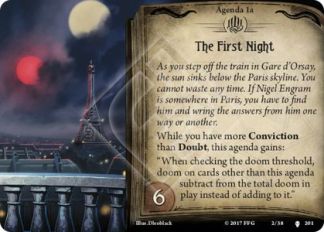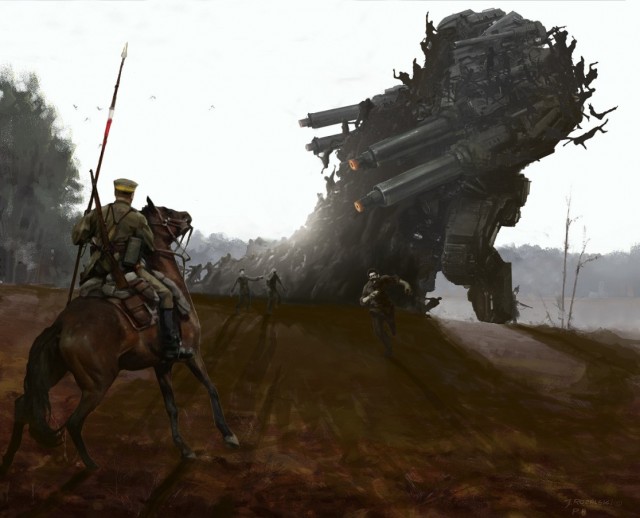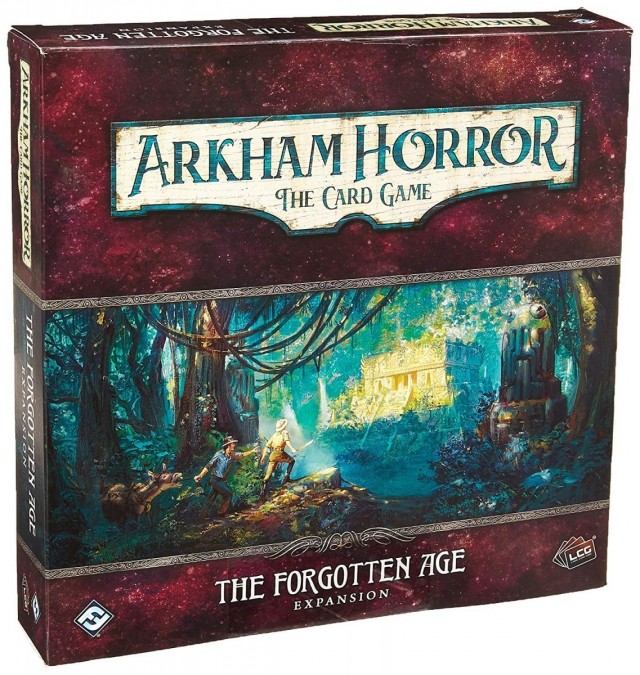This article will look at an individual scenario of Arkham Horror: The Card Game. These will be my impressions after playing through the scenario and will be focusing on the mechanics and how those reinforce the story elements of a given scenario. These articles will contain extensive spoilers and assume a familiarity with the terms and mechanics of the game. Please do not read on if you have not played the scenario in the title yet.
In addition, please note that this particular breakdown will include some fairly heavy implied spoilers for The Unspeakable Oath if you are reading these articles out of order.
The events at the Asylum were shocking, possibly campaign ending for the investigators. Whether you are continuing with your investigators, or starting afresh, you find yourself in the same position: your sleep disturbed by strange dreams. This scenario begins even before the setup with a descent into your dreams!
Gently you explore your dreamscape, through a kind of choose your own adventure partially influenced by what has gone before. Your previous actions ripple across time to affect you now, once more tying this scenario back to the events of the Play and the Party in the core set. The dreams you read are all out of sequence meaning it is hard to accidentally read things in order, which is a nice touch.
As you wake sweating and fearful of what comes next, you know that you must make your way to Paris and track down Mr. Nigel Engram, the director of the King in Yellow.
Bonjour
This scenario hinges around your Conviction and Doubt, changing radically depending on what has happened in previous scenarios and how much you believe in what is occurring around you. The first act changes based on the comparison of these two stats version 1 for Doubt higher than or equal to Conviction, version 2 for Conviction higher than doubt.


The reverse of the Act card is where things get really interesting.
 The back of version 1, doubt equal to or higher than conviction
The back of version 1, doubt equal to or higher than conviction
 The back of version 2, conviction higher than doubt
The back of version 2, conviction higher than doubt
The path of doubt leads to you chasing the Organist across Paris, desperate to learn what you can about him. The Conviction path leads to him becoming a dangerous enemy hunting you through the streets of Paris and you must survive 3 nights in the city to succeed.
 The path of Doubt leads here
The path of Doubt leads here
 The path of Conviction leads here
The path of Conviction leads here
Before we start walking the streets of the city it is also worth noting that the Agenda for its curious instruction: whilst the path of Conviction is the one you are walking, Doom on cards in play other than on the Agenda count against the Agenda total. Taking the Conviction route means having an Act 2 that will not flip until instructed. That instruction is on the back of Agenda 3, making your time in Paris longer and more dangerous as you are stalked by the organist and he drives you quickly mad with his 3 mental damage. In addition he cannot be attacked in return, leaving you fleeing for your lives as you try and hasten the end of the third day!
 Conviction, he’s coming for you!
Conviction, he’s coming for you!
 Doubt, he wants to run away!
Doubt, he wants to run away!
In this way the Agenda is either a countdown as normal if Doubt rules your mind, or forms a barrier to your task if you have the courage of your Convictions. The designers have subverted what we think we know about the game, urging those on the Conviction path to make the Agendas advance as fast as they can before they succumb to the Organist!
Will you last the three days or do you have to hunt down this mysterious figure and find out all you can? Either way you are going to be running across Paris, using the train station perhaps to get around and dealing with the benefits or hindrances of the locations you find yourself in. As with many scenarios there are two of some of the locations, meaning you never know quite what you are going to find around the streets of Paris.
 Choo choo! Destinations are below, all of which have 2 versions.
Choo choo! Destinations are below, all of which have 2 versions.




The locations have different meanings for you depending on whether you are the hunting or the hunted. Sure the initial Agenda requires clues but after that if you are being hunted by the Organist, Doom is the only thing you really care about. If clues are your thing then you will find them scattered very sparsely about, the biggest value location having only 2 x the number of investigators on it. You are going to need to get a move on!
Whatever the outcome of the scenario, the fate of Nigel Engram will be revealed and the chaos bag changed for the next scenario. I’ll revisit this when we look at The Pallid Mask as our investigators descend into the Catacombs below the city.
Strange Encounters
The act deck is not the only thing to be affected by the Conviction and Doubt that the investigators are experiencing, the encounter deck is also altered. If Doubt is ruling the roost then we remove Twin Suns and Hunting Shadow. This is to stop you using Twin Suns to stop the Doom clock ticking away and also so as to not frustrate you too much when you have to spend the very limited number of clues that you can gather.


Those of the Conviction persuasion, who are not gathering clues for the second act, will find themselves removing False Lead and Black Stars Rise. False Lead in this case is fairly much a dead card in the second act, just becoming a Surge so you can see why they would remove it. Black Stars Rise would allow the players to accelerate the Doom being put on the Agenda and if we remember back to the special instruction on each Agenda, that would bring the game to a quicker close. The designers want you to suffer, just a bit.


The encounter set for this scenario has one of the more horrible Treachery cards I’ve seen in a while. Tortuous Chords can absolutely stop you in your tracks, preventing you from setting up your board state or from whipping tricks out of your deck to try and get yourself out of the trouble you inevitably find yourself in. Low Will characters will have a really hard time of it in this scenario if this hits early!
 Simply horrible, even high Will characters might get hit.
Simply horrible, even high Will characters might get hit.
The rest of the deck has more Byakhee and some cards that summon them in the form of Hunted by Byakhee and Deadly Fate. Interestingly the encounter set for the scenario has its own copy of Frozen in Fear in it, and it’s always horrible to see the return of that card. It is however a little unclear as to why they included a version in the encounter set and didn’t just ask you to pull from the original Striking Fear set as they have done with the Midnight Masks in this scenario. Might just be to keep the setup instructions simpler.
Since you can move around Paris with some alacrity due to the train station, it makes sense to have included cards that frustrate those ambitions, much like some of the locations do already. The creatures in the deck are mostly ones you have come across before with the exception of the Stealthy Byakhee, a creature with a lovely bit of flavour: hard to fight when it first arrives but once you have seen and evaded it, becomes child’s play.
Au Revoir
A Phantom of Truth is an interesting scenario, making the investigators into the hunter or the hunted depending on how things played out in the previous scenarios. Of course knowing how the setup goes, repeat playthroughs can provide the players with all sorts of possibilities, making decisions that will take them down one path or another, or try and walk the line between both possibilities. Nothing is for certain in the Path to Carcosa and the designers continue to toy with us as we pass the halfway mark and head into the later half of the campaign.
The conviction and doubt mechanic allows the designers to have our previous choices truly echo down the story and it is wonderful, and horrifying, to see how they subvert our expectations in this second cycle for the game. Next we will dive into the Catacombs below Paris in the Pallid Mask!
 Games
Games How to resolve AdBlock issue?
How to resolve AdBlock issue? 




















